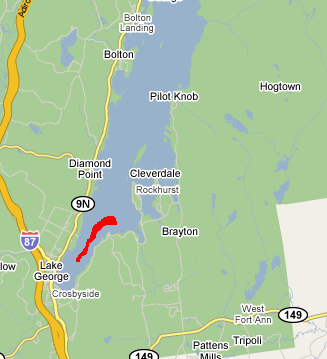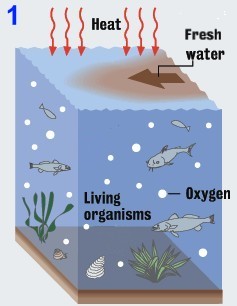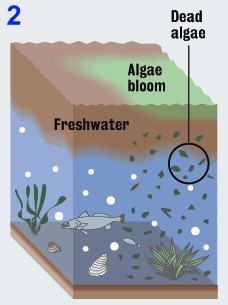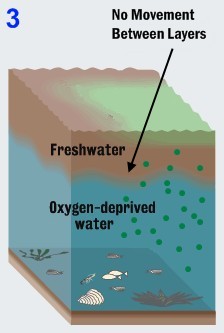
In 1986, Mr. Lawrence Eichler, who nows works for the Darren Freshwater Institute, was credited with discovering an area in the southern part of Lake George which had lower oxygen levels than other areas of the lake during certain times of the summer. (Red area on map above.) This was a new phenomenon starting at that time because even though surveys of the area started in 1980, oxygen depletion was not reported in that area prior to 1986. Since 1986, the area has not grown in size or spread.
Some people have started calling this area the “dead zone”.
In an effort to understand the significance of this area better, I contacted Mr. Eichler directly to learn more. While the term “dead zone” is certainly an attention grabber, the area is certainly not dead.
What makes this issue complex is that during conditions of plentiful oxygen, bacteria consume and break down decaying plant and animal material using aerobic (oxygen-dependent) pathways. However, when oxygen concentrations drop to low levels, anaerobic (a term meaning “without air”) pathways take over and break down decaying material differently.
An important fact in understanding how these processes are intertwined is that some of the nastiest compounds known to man (such as PCBs and PAHs) require both pathways in order to be degraded. As such, the perceived seasonal cycle of aerobic – anaerobic – aerobic pathways, has been shown in many instances to help clean up contaminants.
Mr. Eichler helped me understand this area much better. When asked about the area which is now being referred to as the “dead zone”, he responded to me in an email.
“The so called ‘dead zone’, not named by me by the way, is as the information you unearthed described it. It is an area of the water column near the lake bottom in deep water that becomes depleted of oxygen in late summer just prior to Fall overturn. The term dead zone was coined because fish cannot survive in this area of low oxygen and simply leave. The oxygen depletion is due to bacteria decomposition of organic materials (i.e. dead and dying planktonic algae, leaf debris, etc.) produced in the lake or its watershed. This condition also causes large quantities of phosphorus to be released from the lake bottom with the potential to cause algae blooms.”
“The reason we are concerned is that this condition is more typical of lakes that are more highly enriched than Lake George, and we only observe severe oxygen depletion in the southernmost end of Lake George. Since the lake flows from south to north, as you well know, there is the potential to export the increased nutrient levels from this area northward.”
“Useful anaerobic decompositional processes are occurring in most lake bottom sediments since the majority of lake bottom sediments are anaerobic. It’s just the water column where aerobic processes are generally preferable.”
Phosphorous, which is found in road salt, soap, fertilizer, and sewage is the biggest culprit in causing an oxygen deprived area. Adding phosphorus to the lake is much like adding fertilizer to your lawn except that it will make algae grow in the water instead of making your grass turn green.
The following images should help illustrate this process.

1.) During the spring, sun-heated water runoff creates a barrier, cutting off the deeper water below with oxygen in the air.

2.) Nitrogen and phosphorus from road salt, fertilizer, etc., ignite algae blooms. When the algae die, they sink into the colder water below and decompose, using oxygen up in the deeper water.

3.) Starved for oxygen and cut off from resupply, the deeper water becomes anaerobic. Fish avoid the area but the anaerobic processes start. Winter brings respite with the top waters cooling and merging with the deeper waters but the spring runoff starts the cycle anew.
Sadly, the one contaminant that has almost tripled in Lake George over the last 30 years is road salt. As Mr. Eichler told me in the summer of 2009, salt concentrations have grown from 6 parts per million in 1980 to 16 parts per million in 2008. Instead of working with the towns in the basin to lower road salt applications, the Lake George Park Commission and some elements of the environmental movement are alienating these very towns by pushing the proposed stream stream corridor regulations, which these towns almost universally oppose. These proposed regulations will do nothing to stop municipal road salt runoff into Lake George because they only apply to private individuals and not to municipal or state road crews.
What can we do to see that this problem doesn’t get worse? Well to begin, a number of positive developments are taking place.
1.) The Lake George Association, the Fund for Lake George and Warren County are partnering to create a man-made wetland on the old Gas-Light Village site in Lake George Village to protect the streams flowing through the site which feed this area. The environmental organizations will build the site and the taxpayers of Warren County will be responsible for maintaining it going forward. No property rights have been taken in this project because the property was purchased.
2.) The Department of Transportation has recently made significant improvements to their storm water measures, which the Lake George Association notified us of here.
3.) Additionally, please do not use fertilizer on your yard. Ultimately these chemicals find their way into the lake and are a major source of phosphorous.
4.) Finally, be aware that the Lake George Park Commission’s proposed stream corridor rules will do nothing to prevent road salt from reaching the lake. The proposed rules exempt state and municipal road crews from cutting trenches for road and salt runoff to enter streams. Encourage the Lake George Park Commission to work with town governments in the basin to lessen the use of road salt. Right now the LGPC is alienating towns by their heavy-handed approach. Almost all of the towns in the basin have opposed the proposed stream rules. New technologies and a commitment to lowering road salt will go along way. I believe we should set a goal of bringing the concentration of salt in the lake back to the 1980 level of 6 parts per million. It’s worth noting that this zone only appeared as salt levels went up. Ask candidates running for highway superintendent, what they are doing to lessen the use of road salt.
Finally, don’t let the people who call this the “dead zone” scare you. You now know the facts.
